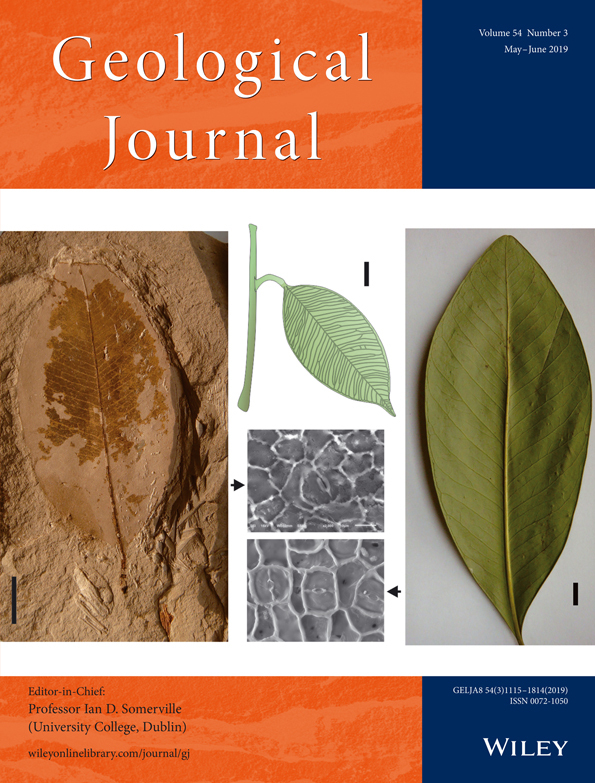Selenium and tellurium concentrations of Carboniferous British coals
Abstract
Standard mode and collision/reaction cell mass spectroscopy methods have been utilized in order to overcome spectral interferences and provide ultra-low quantification of selenium (Se) and tellurium (Te) in British Carboniferous coals for the first time. The accurate detection of Se and Te in coals is becoming increasingly important, as coals and pyrite have been identified as potentially significant trace element sources. The mean Se concentration of British coals bear comparison to that of world coals, with anomalous Se content (concentrations above 4 mg/kg) across westerly exposures, often coinciding with high sulphur (S) content and visible pyrite. New Te data for British coals gives a mean concentration of 0.02 mg/kg, with anomalous Te in Ayrshire. There is a positive correlation in the Te/Se ratio across the sample set. The close relationship between Se and Te, as well as Se–Te with both early syngenetic and later cleat-filling pyrite, confirms an important role for sulphides in Se and Te sequestration in British coals. The high Se-Bowland Shale and/or Ordovician volcanics may have provided the trace element source for British coals of similar or younger age. Regional intrusive activity (shallow tabular intrusions or more extensive plutons) and episodes of intense deformation can alter the thermal maturity of coals and may have driven the movement of trace element-rich fluids through strata, locally enriching coals in Se and Te.
1 INTRODUCTION
Previous research has detailed the relative abundance of trace elements in coal (Cravotta III, 2008a, 2008b; Dale, 2006; Davidson, 1996; Finkelman, Stanton, Cecil, & Minkin, 1981; Liu et al., 2006; Liu, Wang, & Oakey, 2006; Pazand, 2015; Spears, 2015; Spears & Zheng, 1999). However, due to analytical limitations, a complete understanding of selenium (Se) and tellurium (Te) in British Carboniferous coals is lacking. Because of its low abundance, available data for Te in coals worldwide are particularly scarce. The global trend in environmental awareness and need for low carbon energy sources has led to an increasing interest in “strategic elements” such as Se and Te. These elements are essential for future green energy technologies due to their associated photovoltaic and photoconductive properties (Ayres & Talens Peiró, 2013; Lusty & Gunn, 2014; STDA, 2010; Talens Peiró, Méndez, & Ayres, 2011; Woodhouse et al., 2013). Coal has been specifically identified as a promising source for future prospects (Bullock, Parnell, Perez, & Feldmann, 2017; Bullock et al., 2018; Dai and Finkelman, 2018; UKERC, 2012), and pyrite has been noted as a potential source of economic interest for Se (Keith, Smith, Jenkin, Holwell, & Dye, 2017). Both Se and Te occur in low abundances in the Earth's crust (Se = 0.05–0.09 mg/kg; Te = 0.002 mg/kg; Rudnick & Gao, 2003) but are known to be concentrated in specific geological and environmental reservoirs and may be associated with mining activities and reserves (UKERC, 2012). These elements may also form in high concentrations in organic-rich sediments, such as coal (in raw form and as coal ash following combustion). An evaluation of concentrations and controls on Se and Te occurrence in coal is important for understanding resource potential and well as environmental threats relating to their occurrence and processing.
The enrichment of Se and Te in coals compared to crustal abundances reflects the affinity of these trace elements for both organic matter and sulphur (Spears, 2015; Spears, Borrego, Cox, & Martinez-Tarazona, 2007), and possibly for the addition of Se and Te during diagenesis (Diehl, Goldhaber, & Hatch, 2004). Limited data also suggest that trace element contents, including Se, increase with the thermal maturity of coal (Liu, Wang, & Oakey, 2006; Raask, 1985). High Se in British and Irish Carboniferous sediments has been previously identified in organic-rich black shales (Bowland Shale of mid-Visean age; Parnell, Brolly, Spinks, & Bowden, 2016), and it was suggested that Ordovician volcanics may have provided an anomalous source in the watershed. The high Se-Bowland Shale and/or Ordovician volcanics may therefore provide a source of Se (and other trace elements such as Te) to coal strata of similar or younger age. Despite the extensive studies into trace elements in coal, there is still a limited understanding of the processes of preferential accumulation of Se and Te in coal, how they relate to coal properties, and their spatial and stratigraphic distribution in British coalfields. Developments in analytical methods for measuring Se and Te using cold plasma and collision/reaction cell (CRC) interface allow the detection of Se and Te down to ultra-low levels of detection in British coals. This study reports new data for Carboniferous coals from across Great Britain (Figure 1) and, in particular, (a) establishes a database for Se and Te concentrations in a set of coals of similar stratigraphic age; (b) assesses how variable or constant the concentrations are over a wide area; (c) assesses any variability in the ratio of Te/Se; and (d) assesses any relationships between concentrations of Se and Te with percentage organic carbon, percentage sulphur (S), and thermal maturity.
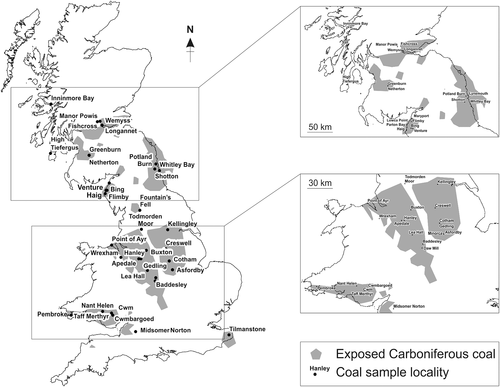
Samples were analysed using both standard mode mass spectrometry methods and CRC microwave-assisted wet digestion methods (Henn et al., 2018) for better detection of low concentrations.
2 METHODS AND MATERIALS
2.1 Sampling and coal properties
Sample localities include exposures and collieries from the coalfields of North West Scotland, across the Midland Valley of Scotland, Northern England, the Midlands, Wales, and Kent (see Table 1 and Figure 1). In total, 44 seam sub-samples were analysed for Se and Te content. Coal rank and thermal maturity indicator information has been compiled based on vitrinite reflectance values. Vitrinite reflectance values for British coals have been collected from a range of sources (Armstroff, 2004; BCURA (The British Coal Utilisation Research Association), 2002; Burnett, 1987; DECC, 2013; Durucan, Ahsan, & Shi, 2009; Parnell, 1992; Vincent & Rowley, 2004).
| British Coalfield | Location | Formation | Se (CRC) | Te (CRC) | Se (STM) | Te (STM) | Vit Refl (mean Ro) | TOC (%) | S (%) |
|---|---|---|---|---|---|---|---|---|---|
| Fife-Stirling | Wemyss | CG | 6.0 | 0.110 | - | - | 2.9 | 52.7 | 5.1 |
| Fife-Stirling | Longannet | CG | 1.6 | 0.013 | - | - | 0.6 | 50.2 | 0.3 |
| Ayrshire | Greenburn | SCM | 1.5 | 0.004 | - | - | 0.6 | 71.8 | 1.7 |
| Ayrshire | Netherton | SCM | 0.7 | 0.020 | - | - | 0.6 | 71.6 | 1.1 |
| Cumberland | Bing | LCM | 1.0 | 0.014 | 1.4 | 0.01 | 0.7 | 54.0 | 0.5 |
| Cumberland | Flimby | LCM | 0.4 | 0.004 | - | - | 0.8 | 79.7 | 0.7 |
| Yorkshire | Kellingley | UCM | 1.0 | 0.014 | 1.8 | 0.02 | 0.7 | 60.5 | 2.2 |
| Derbyshire | Creswell | MCM | 0.3 | 0.012 | - | - | 0.9 | 60.2 | 1.1 |
| North Wales | Point of Ayr | LCM | 1.7 | 0.020 | - | - | 0.8 | 57.0 | 0.8 |
| Nottinghamshire | Cotham | LCM | 5.3 | 0.070 | - | - | 0.5 | 64.8 | 0.9 |
| Nottinghamshire | Gedling | LCM | 0.3 | 0.009 | - | - | 0.5 | 67.2 | 0.7 |
| Leicestershire | Asfordby | LCM | 3.6 | 0.030 | - | - | 0.5 | 53.9 | 0.8 |
| Leicestershire | Minorca | LCM | 1.1 | 0.018 | 0.9 | 0.01 | 0.5 | 56.1 | 0.7 |
| Staffordshire | Lea Hall | MCM | 0.7 | 0.004 | - | - | 0.6 | 63.4 | 0.8 |
| Warwickshire | Baddesley | LCM | 1.5 | 0.016 | - | - | 0.5 | 47.1 | 0.8 |
| Warwickshire | Daw Mill | WG | 1.8 | 0.021 | - | - | 0.6 | 49.0 | 0.9 |
| South Wales | Nant Helen | LCM | 2.9 | 0.047 | - | - | 2.8 | 27.6 | 12.3 |
| South Wales | Cwmbargoed | MCM | 0.7 | 0.004 | - | - | 1.1 | 67.7 | 1.0 |
| South Wales | Taff Merthyr | SWUCM | 2.2 | 0.026 | - | - | 1.9 | 64.0 | 0.6 |
| South Wales | Cwm | SWUCM | 1.2 | 0.012 | - | - | 1.4 | 72.5 | 0.5 |
| Kent | Tilmanstone | WG | 3.3 | 0.066 | - | - | 1.5 | 77.9 | 0.4 |
| Argyllshire | Inninmore Bay | SCM | - | - | 1.8 | 0.04 | 1.4 | 66.4 | 0.6 |
| Fife-Stirling | Manor Powis | CG | - | - | 1.3 | <0.01 | 0.6 | 61.0 | 0.5 |
| Fife-Stirling | Fishcross | CG | - | - | 1.4 | <0.01 | 0.6 | - | - |
| Argyllshire | High Tiefergus | CG | - | - | 5.7 | 0.01 | 1.0 | 59.8 | 0.6 |
| Ayrshire | Greenburn | SCM | - | - | 5.3 | 0.01 | 0.6 | 30.2 | 27.5 |
| Ayrshire | Greenburn | SCM | - | - | 2.2 | 0.04 | 0.6 | - | - |
| Cumberland | Maryport | LCM | - | - | 3.3 | 0.09 | 0.8 | - | 1.0 |
| Cumberland | Venture | LCM | - | - | 1.5 | 0.06 | 0.7 | - | 1.9 |
| Cumberland | Haig | UCM | - | - | 1.4 | 0.05 | 0.8 | - | 1.1 |
| Cumberland | Parton Bay | UCM | - | - | 3.4 | 0.05 | 0.7 | - | 0.1 |
| Cumberland | Lowca Point | UCM | - | - | 2.6 | 0.07 | 0.8 | - | 5.1 |
| Northumberland | Lynemouth | MCM | - | - | 1.0 | 0.02 | 0.7 | - | 1.8 |
| Northumberland | Potland Burn | MCM | - | - | 1.0 | 0.01 | 0.7 | 62.1 | 0.4 |
| Northumberland | Whitley Bay | MCM | - | - | 0.5 | 0.01 | 0.6 | 62.4 | 0.4 |
| Northumberland | Shotton | MCM | - | - | 5.9 | 0.06 | 0.7 | 57.5 | 5.3 |
| Yorkshire | Fountain's Fell | YG | - | - | 0.6 | 0.01 | 0.7 | 71.0 | 0.4 |
| Yorkshire | Todmorden Moor | LCM | - | - | 0.6 | 0.01 | 0.7 | 50.0 | 0.3 |
| North Wales | Wrexham | WG | - | - | 5.6 | 0.01 | 0.7 | 67.6 | 4.2 |
| Derbyshire | Buxton | LCM | - | - | 1.1 | <0.01 | 1.2 | 58.7 | 1.0 |
| Staffordshire | Hanley | UCM | - | - | 0.6 | 0.01 | 0.8 | 31.4 | 0.2 |
| Staffordshire | Apedale | UCM | - | - | 5.6 | <0.01 | 0.8 | 65.9 | 3.0 |
| South Wales | Pembroke | SWUCM | - | - | 1.0 | 0.01 | 2.5 | 69.2 | 4.2 |
| Somerset | Midsomer Norton | MCM | - | - | 0.4 | 0.02 | 0.9 | - | 0.2 |
- Note. Hyphen (-) indicates measurement not taken by method for sample. Method: CRC = collision/reaction cell ICP-MS method; STM = standard mode ICP-MS method. Formation: CG = Clackmannan Group; SCM = Scottish Coal Measures; LCM = Lower Coal Measures; YG = Yoredale Group; UCM = Upper Coal Measures; SWUCM = South Wales Upper Coal Measures; MCM = Middle Coal Measures; WG = Warwickshire Group; Se = selenium; Te = tellurium.
2.2 Se–Te determination
The Se and Te whole-rock content of coals was determined by two techniques: First, selected whole rock samples were analysed as part of a suite of 51 elements using standard mode aqua regia inductively coupled plasma-mass spectrometry (ICP-MS) techniques at ALS Minerals (Loughrea, Ireland). Samples were milled and homogenized, and 0.25 g were digested with aqua regia in a graphite heating block. The residue was diluted with deionized water, mixed and analysed using a Varian 725 instrument (ICP-MS method code ME-MS41). The standard mode lower limit of detection for Se is 0.2 mg/kg and for Te is 0.01 mg/kg. Measurement of four Geological Certified Reference Material (CRM) standards were within the anticipated target range (upper and lower bound) for each metal and standard. The CRMs used for calibration were MRGeo08 (mid-range multi-element CRM), GBM908-10 (base metal CRM), OREAS-122, and OGGeo08 (ore grade multi-element CRMs). Duplicate analyses of two samples produced reported values within the acceptable range for laboratory duplicates, with a mean relative percent difference of 4%. Duplicate analyses included samples processed through the entire analytical procedure.
Second, selected samples were digested by microwave assisted wet digestion (MAWD) and Se and Te determined by ICP-MS. Samples were ground using a cryogenic mill, with 2 min of pre-cooling time followed by 3 min of grinding. Cryogenic milling was used to minimize the risks of contamination as it is performed in closed environment (avoiding contamination by the atmosphere of laboratory) and provides a very fine particle size in a relatively short time, important for the anticipated low levels of Se and Te in the coal sample set. Samples were oven dried at 105 °C for 2 hr before use. The microwave-induced combustion method for coal analysis is comprehensively detailed by Flores et al. (2008).
Coal was digested by MAWD using a microwave oven (Multiwave 3000®, Microwave Sample Preparation System, Anton Paar, Graz, Austria, software version v1.27-Synt) equipped with up to 16 PTFE vessels with 100 ml of internal volume and maximum operational temperature and pressure of 220 °C and 40 bar, respectively. Experiments were carried out using 250 mg of sample (diluted to 25 ml). These operating conditions were used to select suitable dilutions prior to Se and Te determination to avoid C interferences.
Hydrofluoric acid (40%) was used without previous purification for digestion by MAWD. Water was purified using a Milli-Q system and used to prepare all standard solutions and reagents. Concentrated HNO3 (65%) was distillated in a subboiling system for MAWD and preparation of reference solutions. Reference solutions of Se and Te (0.01 to 10 μg/L) were prepared by sequential dilution of a stock solution (1,000 mg/L) in HNO3. Argon (99.998%) was used for plasma generation, nebulization and as auxiliary gas and hydrogen (99.999%) was used in the CRC.
In order to evaluate the MAWD method, select samples were digested by MAWD using three digestion solutions: (a) 4 ml HNO3 + 1 ml HCl + 1 ml HF, (b) 4 ml HNO3 + 1 ml H2O2 + 1 ml HF, and (c) 7 ml HNO3 + 1 ml HF. No statistical difference (ANOVA) was observed between the results obtained for Se and Te among all evaluated methods. These results indicate that the digestion solution (HNO3 + HF) was suitable for Se and Te recovery for coal and other reagents, and HCl or H2O2 were not required. The accuracy of MAWD method was evaluated using two CRMs: NIST 1635 (subbituminous coal) and SARM 20 (coal). No statistical difference (t test, 95% of confidence level) was observed between results obtained for CRMs and the certified values.
A quadrupole-based ICP-MS (NexION 300X®, Perkin Elmer, Canada) equipped with a concentric nebuliser, a cyclonic spray chamber, and a quartz torch with a quartz injector tube was used. In order to avoid any damage to the nebulization system of the ICP-MS instrument due to the HF content in digests, a dilution factor of 10 was used for sample analysis. The ICP-MS instrument was equipped with a cell that can be used both as a collision cell and as a dynamic reaction cell. This collision/reaction cell (CRC-ICP-MS) method allows for lower levels of detection of Se and Te by minimizing the occurrence of spectral and nonspectral interferences. With standard mode ICP-MS methods, spectral interferences occur at the most abundant isotopes of Se. Here, hydrogen gas was utilized in order to effectively minimize the spectral interferences of the argon-based polyatomic ions at m/z 77, 78, and 80. For Te, m/z 128 was monitored for spectral interferences. In order to limit polyatomic interferences with argon-, matrix-, and solvent-based ions, Se determination must be carried out by monitoring 78Se isotope. Under optimized conditions, the instrumental and method limit of detection was 0.01 μg/L, suitable for Se and Te determination at very low concentration in coal. The overall effectiveness and importance of the method for ultra-low Se determination is further detailed in Henn et al. (2018).
2.3 Total organic carbon and sulphur content
Total organic carbon (TOC) and sulphur (S) contents were measured using a LECO CS225 elemental analyser, after decarbonatization with hydrochloric acid, to a precision of ±0.05%. Analyses were run concurrently with CRMs 501-024 (Leco Instruments, 3.23 ± 0.03% C, 0.047 ± 0.003% S, instrument uncertainty ±0.05% C, ± 0.002% S) and BCS-CRM 362 (Bureau of Analysed Samples Ltd., 1.48% S). The instrument was calibrated using these CRMs. The repeatability of sample results was consistently within 1%, based on the three runs of CRM certified versus obtained values, and uncertainty was determined based on the results of three blanks. Blank sample measurements provided the methodological interference response from three analyte-free samples. The resulting trace S and TOC values obtained for the blank samples were then algebraically subtracted from the standard and sample responses to avoid analytical interferences.
3 STRATIGRAPHY AND SEDIMENTOLOGY
The coal samples from British coalfields are all of Carboniferous age, predominantly represented by Coal Measures. The Coal Measures Supergroup of the UK extends from the Midland Valley of Scotland, across the north of England, to the Midlands, South Wales, and Kent. The widespread development of coal-bearing strata formed early in the European Westphalian equatorial climatic (delta-top) conditions (Fielding, 1982; Spears, 2015; Waters, Browne, Dean, & Powell, 2007). The depositional environment was characterized by low-lying paralic delta plains with abundant vegetation and major river distributaries (Spears, 2015). The main coal-bearing intervals comprise the Lower and Middle Coal Measures, formed during the Westphalian A and Westphalian B to Lower C in a fluvial coastal plain environment (Gayer, Peŝek, Sykorova, & Valterova, 1996). This was dominated by overbank mudrocks, representing deposition in extensive interdistributary lakes (Gayer et al., 1996). The start and end of the Carboniferous (into the Stephanian) was marked by a climate that was (at least seasonally) arid (Waters et al., 2007). An increase in sand content and a climatic shift to drier conditions led to a decrease in the number of coal seams during the Westphalian C, Westphalian D and Stephanian (Besly, Burley, & Turner, 1993; Kombrink, 2008). The Coal Measures were strongly affected by post-depositional Variscan fold and thrust deformation, and such deformation resulted in a set of superimposed tectonic fractures on the coals, partially obliterating a cleat fracture system (Frodsham, Gayer, James, & Pryce, 1993; Gayer et al., 1996; Gayer & Nemcok, 1994; Owen, 1974; Woodland & Evans, 1964). Although all the sampled coals are Carboniferous in age, there are several subformations and some age variations across the sample suite. Samples span the range (from youngest to oldest): Upper Coal Measures and South Wales Upper Coal Measures (Westphalian C in age), Middle Coal Measures and Warwickshire Group (Westphalian B), Lower Coal Measures and Scottish Coal Measures (Westphalian A), one Yoredale Group sample (Namurian), and Clackmannan Group (Visean; Figure 2).
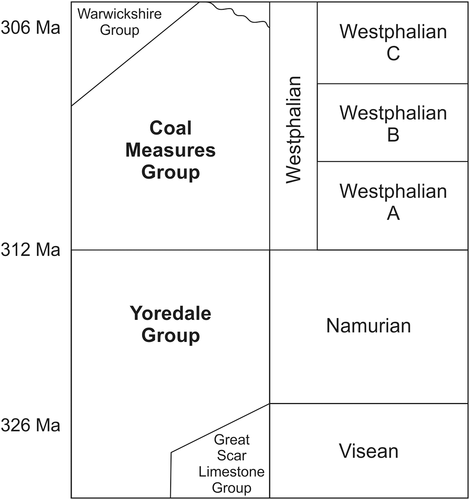
4 RESULTS
4.1 Coal properties
The majority of British coal samples are bituminous in coal rank, although some samples from the South Wales Coalfield are anthracitic. The arithmetic mean vitrinite reflectance value is 1.1, with typically higher thermal maturity values in South Wales (vitrinite reflectance values of 1.1–2.8) and Fife-Stirling (2.9; Table 1). Samples from Ayrshire, Northumberland, Cumberland, North Wales, and Staffordshire contain visible pyrite, including disseminated and concretionary banded (bedding-parallel) pyrite, and discordant, typically vertical, cross-cutting pyrite (i.e., cleat-hosted pyrite concentrated within small fractures). Samples from Ayrshire include 1-cm thick bands with a high pyrite content. Samples contain a mean moisture content of 4.8%, fixed carbon content of 60%, vitrinite of 78% maceral content, and volatile matter content of 30% (BCURA, 2002).
4.2 Se–Te content of British coals
Results are shown in Table 1 and Figures 3-9. The world mean Se content of coals has been previously estimated in several studies, generally giving a range of 1–3 mg/kg (Nalbandian, 2012; PECH, 1980; Valkovic, 1983; Yudovich & Ketris, 2006). Here, Se values in excess of 4 mg/kg are considered anomalous. This is based on concentrations known to lead to environmental implications (e.g., 3.6 mg/kg mean Se in British Columbia coals; Vesper, Roy, & Rhoads, 2008).
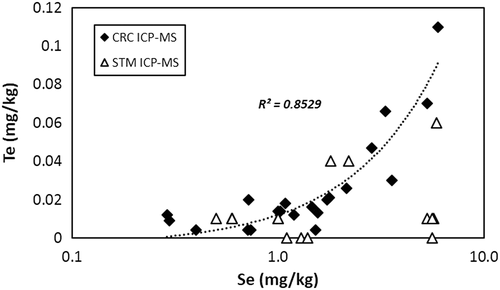
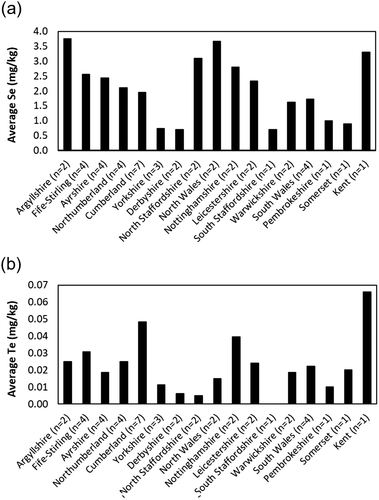
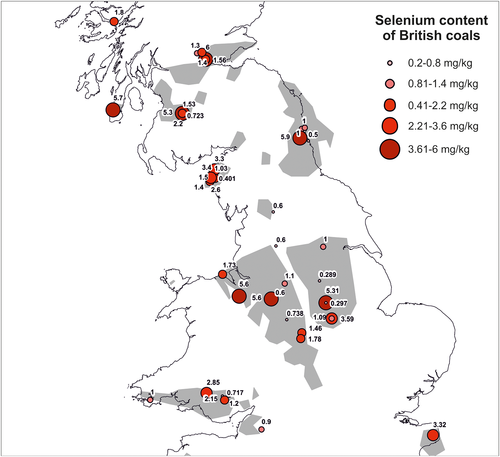
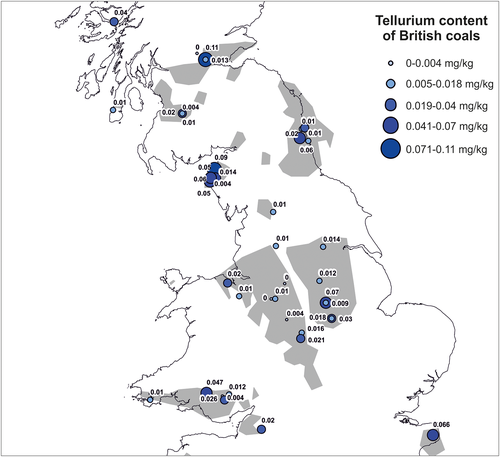
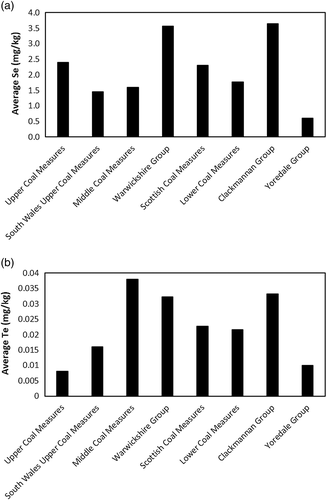
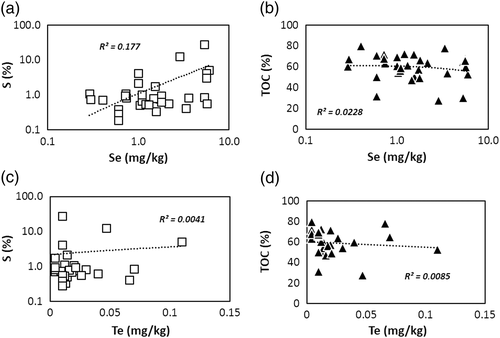
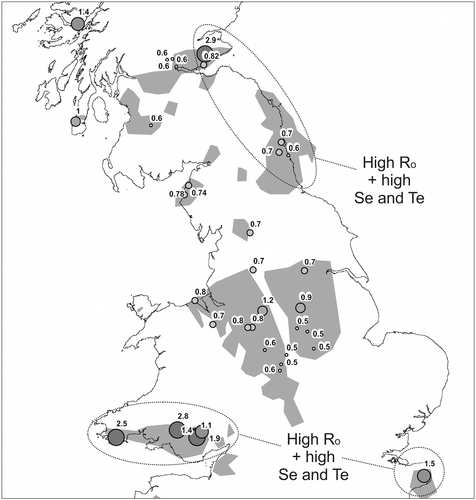
The arithmetic mean British coal Se content for samples analysed in this study is 2.1 mg/kg, in line with the world mean content and slightly higher than the British mean of Spears and Zheng (1999). This value is slightly higher than the world mean Se content for bituminous coals of 1.6 mg/kg (Yudovich & Ketris, 2006). Overall, samples with detectable Te show an increase with increasing Se, with a strong positive correlation (linear trendline R2 value = 0.85, calculated using Microsoft Excel; Figure 3). The standard mode method shows a mean Se content of 2.5 mg/kg, similar to that of the CRC method of 2.3 mg/kg. Ayrshire (3.7 mg/kg) and North Wales (3.7 mg/kg) show the highest mean regional Se content from the sample set (Figure 4). Anomalous Se is recognized in individual coal sample localities from Fife-Stirling (6 mg/kg), Northumberland (5.9 mg/kg), Nottinghamshire (5.3 mg/kg), Argyllshire (5.7 mg/kg), Ayrshire (5.3 mg/kg), North Wales (5.6 mg/kg), and Staffordshire (5.6 mg/kg). Figure 5 shows that high Se tends to occur in westerly coal exposures (e.g., Western Scotland, North and South Wales, Cumberland, and Staffordshire) as well as in Northumberland and Fife-Stirling.
The mean Te content of British coals is 0.02 mg/kg. The highest recognized Te content of any British coal sampled is from Fife-Stirling (0.11 mg/kg), an order of magnitude higher than the estimated world mean Te value (Table 1). The Midland Valley of Scotland and Argyllshire typically show higher Te content (mean 0.03 mg/kg), and coal samples from Cumberland (max. 0.09 mg/kg, mean 0.05 mg/kg), Nottinghamshire (max. 0.07 mg/kg, mean 0.04 mg/kg), Northumberland (max. 0.06 mg/kg), and Kent (max. 0.07 mg/kg) also show higher values (Figures 4 and 6, Table 1). The mean Te content by standard mode method also compares well to the CRC method (0.02 and 0.03 mg/kg, respectively). Whilst Te values measured by both methods compare well, the three coals that were measured by both methods show some analytical variation with Se calculations: the Minorca (Leicestershire) sample shows a good agreement for Se of 1.1 (CRC) and 0.9 mg/kg (STM), whereas Bing (Cumberland) and Kellingley (Yorkshire) show slightly overestimated Se by standard mode (1.4 and 1.8 mg/kg, respectively) compared to CRC (1.0 mg/kg for both samples).
Clackmannan Group and Visean age samples contain the highest mean Se and high Te (3.6 and 0.03 mg/kg, respectively), whereas the Westphalian samples show a similar range of mean Se (1.9–2.2 mg/kg) and Te (0.01–0.02 mg/kg) contents (Figure 7). Middle Coal Measures samples show the highest average Te (0.04 mg/kg). The Yoredale sample contains the lowest overall Se (0.6 mg/kg) and Te (0.01 mg/kg) for the sampled strata (Figure 7). There is a slight positive correlation between Se and S (Figure 8a), but no strong relationship between Se and TOC (Figure 8b). There is no strong relationship between Te and S, nor Te and TOC (Figure 8c,d). There is very high S in Ayrshire coals (27.5%), attributed to high pyrite content (completely pyritic seams in coal). Northumberland, Cumberland, South Wales, Ayrshire, Fife-Stirling, Yorkshire, Staffordshire, North Wales, and Pembrokeshire contain anomalous S content and visible pyrite. Here, anomalous S concentrations are values considered above 1.3%, the cut-off value for S content of coals acceptable for local power generation in Northumberland (Turner & Richardson, 2004). Figure 9 shows that some higher Se and Te content coals coincide with higher vitrinite reflectance values (e.g., Kent, South Wales, Fife-Stirling, and Northumberland).
5 DISCUSSION
5.1 Comparison to world coals
Results show that British coals contain typical Se concentrations comparative to world Se coal content. Previous databases for Australia, the United States, UK, and Iran record mean Se values of 1.02, 1.7, 1.8, and 1.2 mg/kg, respectively (Coleman, Bragg, & Finkelman, 1993; Pazand, 2015; Riley et al., 2007; Spears & Zheng, 1999). Elevated Se levels in coal have led to a suggestion that coal might be a global resource for the element, of up to 500,000 tonnes, based on a content of 0.5 mg/kg (Speirs, Houari, Contestabile, Gross, & Gross, 2013). Two regions where coal waste is regarded as an environmental problem, British Columbia (Wellen, Shatilla, & Carey, 2015) and West Virginia (Lindberg et al., 2011), have mean Se contents of about 2.6 and 3.6 mg/kg, respectively (Kennedy, Day, Mackie, & Pesonen, 2015; Vesper et al., 2008). All of these mean values are lower than the 4 mg/kg level considered anomalous, above which 6 of the 15 British regions measured. The regions of high Se content in British coals do not match to regions of anomalously high stream water Se content (Salminen, 2005).
Previously, Te was seldom recognized in coals worldwide due to its low abundance. The mean Te content of world coals has been taken at 1/100 of world mean Se content, giving a mean world Te content of 0.015 mg/kg (Davidson & Lakin, 1973). As a result (and with no known previous analysis of Te in British coals for comparison), any Te above this world mean value is considered anomalous, though concentrations are too low to be considered significant in any economic or environmental sense. Limited previous data for Te in coals from China, Japan, Australia, and UK are all in the range 0.02–0.08 ppm (Hashimoto et al., 1989; Spears & Tewalt, 2009; Woo, Watanabe, Hashimoto, & Lee, 1987), similar to the values determined in British coals.
5.2 Source and enrichment of Se and Te in British coals
High Se in the Bowland Shale and underlying Ordovician volcanics (Parnell et al., 2016) may have provided the initial source for Se and Te for British coals of similar or younger age. This is particularly true of upper Visean-Namurian Clackmannan Group (Waters et al., 2007, 2011) samples, which were deposited at a similar time to the Bowland Shale. The limited overall Se and Te range of Westphalian A–C samples suggests there was little variation during the Westphalian period, which suggests that local variations in thermal maturity and mineralization may play a role in the regional and stratigraphic trace element patterns of enrichment throughout Great Britain. There are some correlations of Te and Se with high vitrinite reflectance (Figure 8), which may indicate that more thermally mature coals contain higher trace element content, previously attributed to uptake from groundwaters during burial (Raask, 1985).
Causes of thermal maturity in coal, such as igneous intrusions heating the strata, may also be accompanied by trace element-carrying hydrothermal fluids percolating through coals, precipitating as pyrite. Dissolved metals in fluids can enhance Se and Te content of coals and have been suggested for Carboniferous coals in Ayrshire (Bullock et al., 2018) and Jurassic coals in Brora (Bullock et al., 2017). The close proximity of the South Wales, Cumberland, and Northumberland coalfields to granitic intrusions (e.g., Shap and Skiddaw granites of Cumberland, Dartmoor granite in southwest England, Weardale granite in northeast England), associated deformation which produced a series of faults through the coal strata (forming cleat systems), or later Variscan activity (in the case of South Wales), may have provided a source and/or flow pathway for hot metal-rich fluids and subsequent increased maturity and trace element enrichment to these coals (see also Gayer et al., 1996; Turner & Richardson, 2004). The Clackmannan Group coals in Fife-Stirling shows higher mean Se and Te, which may be attributed to the 18-m thick Midland Valley Sill complex causing local heating of strata (Vincent, Rowley, & Monaghan, 2010), which may be responsible for the higher thermal maturity, and may have provided a potential source and/or fluid transport mechanism for chalcophile elements through the strata. Enrichment of Se (and possibly) Te regions such as Northumberland and the northern Pennines may be additionally influenced by seawater distribution, with periodic inundation by the sea into low-lying deltaic planes (Cann and Banks, 2001; McKay and Longstaffe, 2003; Turner and Richardson, 2004; Bouch et al., 2006; Spears, 2015; 2017).
There is also a positive correlation in the Te/Se ratio (Figure 2), suggesting a close relationship between the two elements, both substituting for S in pyrite. Selenium can substitute readily for S in many sulphide minerals and can also be precipitated by sulphate-reducing microbes (Hockin & Gadd, 2003; Parnell, Bellis, Feldmann, & Bata, 2015). In coals, Te also has an indirect association with organic matter, and microbial activity can concentrate both Se and Te. High Se and Te coals recognized in this study typically contain visible pyrite (e.g., samples from Ayrshire, Northumberland, South Wales, and Staffordshire). The role of pyrite is therefore pivotal in sequestration of Se and Te in coals. However, the cross-plot of Se versus S indicates only a slight a positive correlation, with several outliers (Figure 8a). This may therefore suggest that pyritic S is important in Se and Te sequestration, but sulphate and organic sulphur content in coals do not play a pivotal role in Se and Te sequestration, resulting in the data point outliers and a lack of correlation for total S versus Se and Te. Though Se and Te have an affinity to organic matter (binding to the surface), the lower trace element content in nonpyritic coal compared to pyritic coal suggests that organic matter may elevate mean concentrations above world average crustal compositions but is unlikely to play a significant role in enrichment compared to other coals and organic-rich sediments.
Pyrite abundance appears variable across the sample set. High Se in Fife-Stirling, Ayrshire, Cumberland, Northumberland, North Wales, and Staffordshire coincide with high S and visible pyrite in sampled coals. Pyrite occurs in coal as early (syngenetic) replacement minerals, and later (epigenetic) cleat-filling pyrite (Cavender & Spears, 1995, 1997; Spears & Caswell, 1986; Spears & Tewalt, 2009). Samples from the South Wales, Ayrshire and Northumberland coalfields show the highest pyrite abundance, with disseminated pyrite, banded pyrite and later stage cleat pyrite evident. In previous studies, Se has been shown to be more abundant in early forms of pyrite (Large et al., 2014). However, late stage epigenetic fluids are also known to be responsible for high concentrations of trace elements in some coals (Bullock et al., 2018; Diehl et al., 2004; Spears & Tewalt, 2009; Yudovich & Ketris, 2006). The presence of pyrite infilling cleats indicates a later period of formation. Cleats can provide channels for fluid flow, and the host coal can offer a source of reduced S for bacterial sulphate reduction (Bullock et al., 2018; Hatch, Gluskoter, & Lindahl, 1976). The development of cleats provides a locus for pyrite precipitation, and associated Se and Te.
6 CONCLUSIONS
A combination of standard mode and collision/reaction cell ICP-MS analytical methods have led to the establishment of Se and Te concentrations of Carboniferous British Coal Measures to ultra-low levels of detection.
- British coals contain typical Se concentrations comparative to world Se coal content, with anomalously high content in westerly coal exposures (Argyllshire, Ayrshire, Fife-Stirling, Cumberland, Nottinghamshire, North Wales, and Staffordshire), Northumberland and Fife-Stirling. The high Se-Bowland Shale and/or Ordovician volcanics may have provided a source of Se (and other trace elements such as Te).
- Based on a combination of CRC and standard mode ICP-MS methods, the mean measured Te content of British coals is 0.02 mg/kg. The highest recognized Te content is from Fife-Stirling, a magnitude higher than the estimated world mean Te value.
- High Se in Fife-Stirling, Ayrshire, Cumberland, Northumberland, North Wales, and Staffordshire coincide with high S and visible pyrite in sampled coals. There is a positive correlation in the Te/Se ratio, suggesting substitution for S in pyrite and an important role of pyrite in sequestration of Se and Te in coals. Se and Te may be typically more abundant in early forms of pyrite, but the development of cleats provides a locus for pyrite precipitation and associated higher Se and Te.
- Regional variations in coal maturity and mineralization trends relating to igneous intrusions or episodes of deformation may play a role in the variations in Se and Te enrichment in British coals Enrichment in some areas may be additionally influenced by seawater distribution and inundation into low-lying deltaic planes.
ACKNOWLEDGEMENTS
The authors wish to thank Kier Group, the British Coal Utilisation Research Association (BCURA) and Uniper (E.On) for kindly providing coal samples. The authors are grateful to Conselho Nacional de Desenvolvimento Científico e Tecnológico (CNPq), Coordenação de Aperfeiçoamento de Pessoal de Nível Superior (CAPES), and Fundação de Amparo à Pesquisa do Estado do Rio Grande do Sul (FAPERGS) for supporting this study. The authors are grateful for the thorough and constructive comments from two anonymous reviewers, as well as the careful editorial handling of Prof. Ian Somerville. This work was supported by the NERC under Grant number NE/L001764/1.
CONFLICT OF INTEREST
The authors declare no conflicts of interest.



